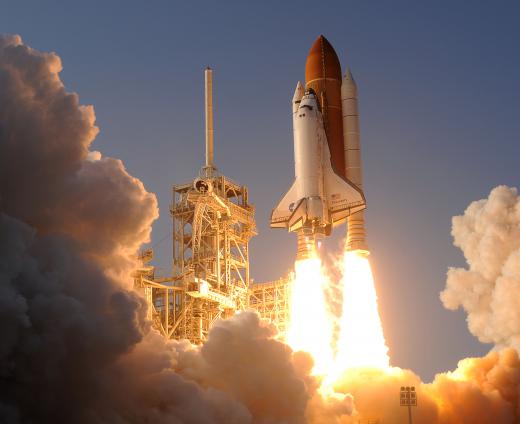What is the Most Expensive Substance in the World?
 Michael Anissimov
Michael Anissimov
In terms of production costs, the most expensive substance in the world is antimatter. The cost of creating this material has been estimated at about $1,771 trillion US Dollars (USD) per ounce ($62.5 trillion USD per gram), although some authorities think it may eventually come down to a mere $141.75 billion USD per ounce ($5 billion USD per gram). This is the cost of antihydrogen, the simplest form of this type of substance, and the antimatter equivalent of the element hydrogen. Other anti-elements would be even more expensive. As of 2013, only small numbers of antihydrogen atoms have been produced — for research purposes only — and the substance is not available for sale.
Why Antimatter is so Expensive

Antimatter consists of particles that can be considered the opposites of their normal matter counterparts. The matter people are familiar with is made up of atoms, which consist of a nucleus containing heavy, positively charged, particles called protons surrounded by a “cloud” of lightweight, negatively charged electrons. Atoms of antimatter have negatively charged antiprotons in the nucleus, with positively charged anti-electrons — normally called positrons — surrounding them. Although antiprotons have been detected in cosmic rays, and positrons are emitted by some radioactive elements, there is no known natural source of anti-atoms, so antimatter has to be manufactured.

Positrons can be obtained quite easily from materials that emit them, but the much heavier antiprotons have to be created in particle colliders — machines that send subatomic particles crashing into one another, and into other materials, at enormous speeds. These collisions concentrate tremendous amounts of energy into extremely small volumes of space, which results in the creation of matter in the form of particles and antiparticles, including antiprotons. These can be separated magnetically, and combined with positrons to make atoms of antihydrogen.
Since these anti-atoms can only be made at a handful of facilities, and only in tiny quantities, antihydrogen is extremely scarce. Not only is it difficult and costly to make, it is also difficult to trap and store. Anti-atoms are strongly attracted to normal atoms, due to electrons and positrons having opposite electrical charges, and when they meet, they annihilate one another, with all their mass turning into energy. Storage involves vacuum containers that keep the anti-atoms from touching the sides using magnetic fields. These factors combine to make antimatter the world’s most expensive substance.
Uses for Antimatter
Scientists would not go to the trouble of making this substance if it did not have some potential uses. Antimatter has the greatest energy density of any possible fuel, meaning that it has the potential to release more energy per unit weight than any other substance. Since it takes even more energy to produce antimatter than can be obtained from it, it is not a solution to the planet’s energy problems; however, it has been proposed as a possible future rocket fuel, as, in theory, it could accelerate a payload to a substantial fraction of the speed of light. For the moment, though, its main interest to scientists lies in what it can reveal about the laws of physics.
Other Expensive Substances
Still in the realm of exotic physics, nuclear isomers, although falling some way short of the world’s most expensive substance, would carry an extremely high price tag — possibly over $28 billion USD per ounce ($1 billion USD per gram). These are elements in which the atomic nucleus has more than its minimum amount of energy — the minimum being known as the “ground state.” In most cases, a nucleus in this “excited” state will revert to its ground state within a tiny fraction of a second, releasing energy in the form of gamma rays, but some nuclear isomers, such as hafnium-178m2 and tantalum-180m, are relatively stable and long-lived. Under normal circumstances, these isomers release energy slowly, as their nuclei revert randomly over a long period.
Experiments in the 1990s seemed to show that a sample of hafnium-178m2 could be triggered to revert to its ground state all at once, releasing large amounts of energy, by bombarding it with X-rays. This raised the possibility of using the isomer to store energy, or to develop new types of weapon. Attempts to reproduce the effect, however, have so far failed, and many scientists are very skeptical about these possibilities. As with antimatter, these substances need to be manufactured in expensive particle colliders, and are available only in tiny amounts.
AS FEATURED ON:
AS FEATURED ON:












Discussion Comments
You're going on about LSD being about 15 or twenty dollars? Which in English money is about ten or twelve quid (pounds). You're all being ripped off. This discussion is about antimatter and the energy that it releases should it be in contact with matter. It's the most expensive substance known to a known being with any intelligence, and you people talk about drugs. I'll bet you'll start talking about McDonald's being pricey. The most expensive substance known to anyone are children. They cost an arm and a leg and your sanity.
@Anon261305: Anon171276 is not crazy. If you actually read the previous posts, you might realize that a hit of LSD contains far less of the drug than a hit of heroin, and is therefore far more expensive pound for pound. If you actually read Anon171276's post, he or she already said that a hit is about $15.
Making an antimatter bomb to destroy the planet using imaginable technology is pretty stupid. Tthe energy required to make such a bomb would be enough to destroy countless planets.
Most people are clueless about antimatter as far as it stands.
A single gram of antimatter costs $17 trillion dollars to produce. This is because antimatter involves the process of smashing particles together, obtaining positirons then putting the positirons within a chamber in order to attract antiprotons. That's how we make one atom of antihydrogen.
This technology could potentially make us a bomb that could disintegrate an entire planet. Therefore, it is by far the most expensive resource on the planet.
@Anon171276: Are you crazy? A hit of LSD is 15 dollars. Looks like you're getting ripped off big time, but I don't know. In Goa, India, a hit is 800 rupees, which is like around 15 dollars.
The problem with anti-matter is that it doesn't have a specific "value" as it (as far as I am aware) has never been sold to anyone, so thus far, antimatter is essentially worthless, Consider that just because it might cost trillions of dollars to make doesn't mean it is worth trillions of dollars.
@Facebook_User_563721001: I'm not sure how plutonium is weighed, or if it is ever sold in the public market, like copper or gold. That may be the reason you couldn't find a price for it.
Diamonds are not priced by the ounce, but by carat, which is, I believe, their weight and dimension. Also, they are priced by cut, quality and color, as well. A completely colorless diamond with no flaws (or inclusions) weighing a half-carat may be worth more than a one-carat diamond whose quality is not as good. So it is difficult to compare using diamonds, since their price is determined by many more factors than just weight.
Just for the sake of comparison, how much are diamonds, plutonium etc. per ounce? I couldn't find the per ounce prices.
@genevamech: Your heroin is nothing compared to LSD. Just sayin'.
The most expensive drug in the world is LSD by far. One hit of lsd is about 15-20 dollars. lsd is active at about 100 micrograms. a typical hit of lsd is about 250 micrograms. Four times that is 1 milligram at about 60 dollars. so 1 gram is about 50,000 dollars, and with 28.5 grams in 1 ounce you have about 1.5 million dollars. multiply that by 16 minus about 20 percent and you got your pound- 20 million dollars. In kilos that would be roughly 30-35 million dollars.
if you want to talk about drugs, pure crystal dmt sells for about $300 a gram, whereas cocaine is $60, and marijuana is about $15. Put that in kilos and you're talking more like roughly $200,000 a key.
yeah it would be if you bought the actual pure drugs. those blocks are probably not 100 percent heroin. the street stuff are probably only like 10 percent actual drugs and the rest is some random chemicals mixed in. besides, most people only need a couple of pills a week. ecstasy at $20 a pill depending on who you know.
with a market like that, just legalize it already. then you would have an extra $100 billion in revenue to help people instead of going to some drug lord down in mexico.
that's the problem with the conservatives. we know it's going to mess with our bodies, but people are human and that means they are doing it anyway, whether we tell them to or not. Best example was the game addict in Korea who died from playing at an Internet cafe.
If they were so concerned with their citizens consuming drugs, they should have psychologists determine each individual's cause to be depressed enough to take that stuff. the drugs are just a suppressant for people's stress. enough ranting, back to work.
@ Comparables- The Department of Justice publicizes drug seizures and prices for major drugs. You make a good point about the cost of these substances and the amount of money in the illegal drug trade.
The DEA Factsheet website actually pegs the high price of heroin at $200,000 per kilogram. Five pounds could buy you a nice spread in almost any state.
The DEA alone seizes about 2500 kilograms of heroin per year. That is about two and a half billion dollars worth of heroin. Imagine how much still enters the market. Then add in all of the major drugs sold in this country. The illicit drug market could easily top $300 billion per year.
I was watching a show on National Geographic about the drug trade, and I was surprised to find out how expensive some of these drugs are. The show said that a kilo of heroin sells for more than $100,000 in the United States.
That is a pretty expensive substance. Five pounds is the equivalent of a house or an exotic sports car. It is a wonder that there are so many drug addicts in this country when drugs are so expensive. It makes you wonder how much of the American economy is tied up in illicit drugs.
Post your comments